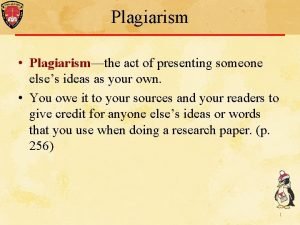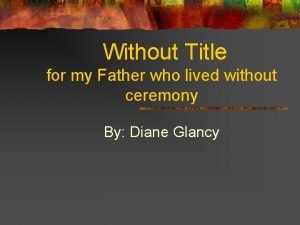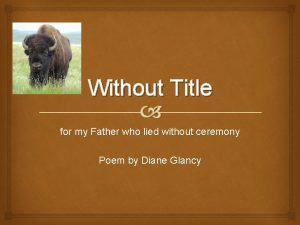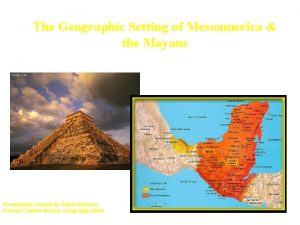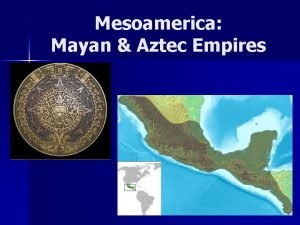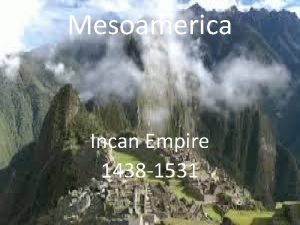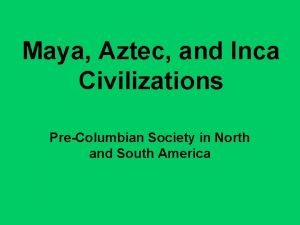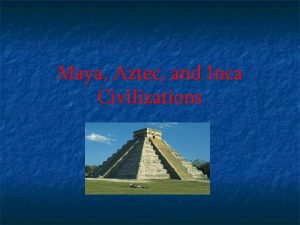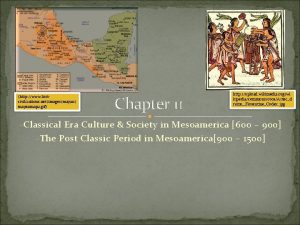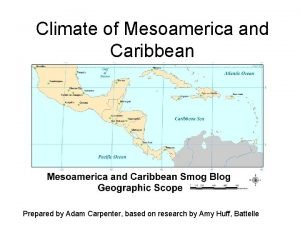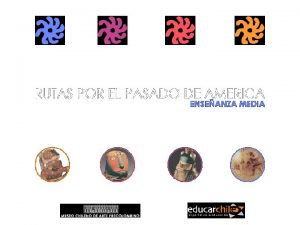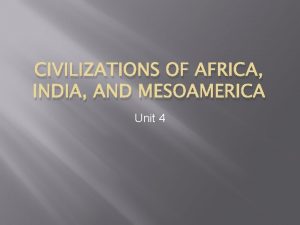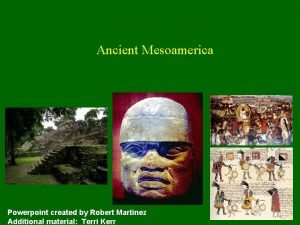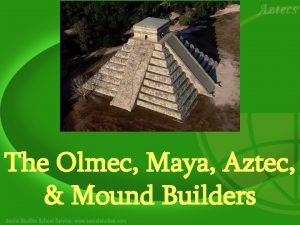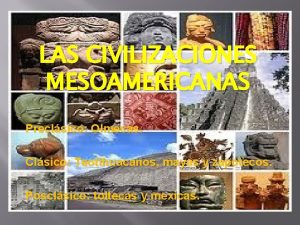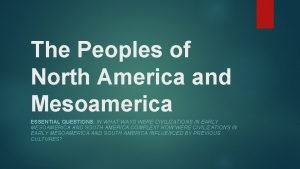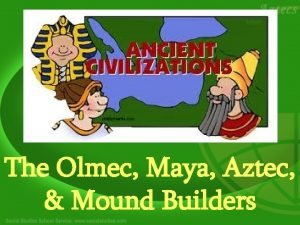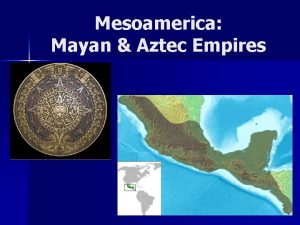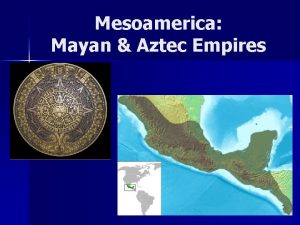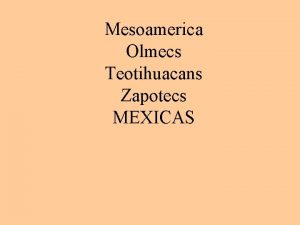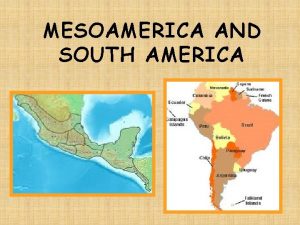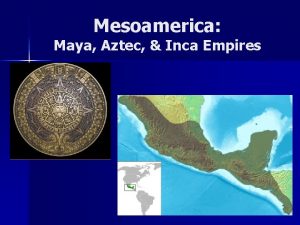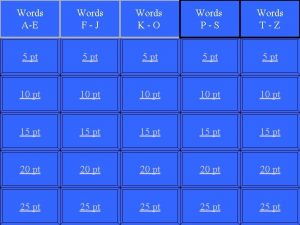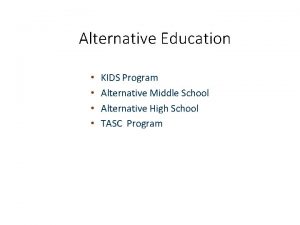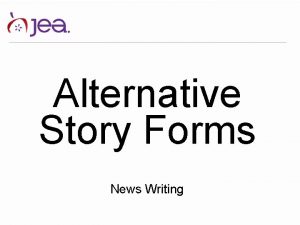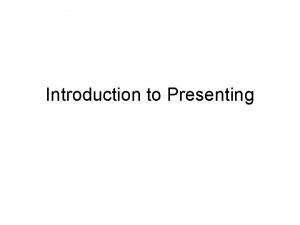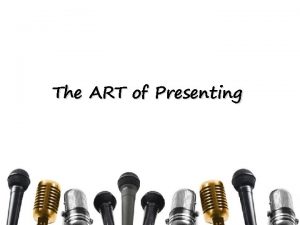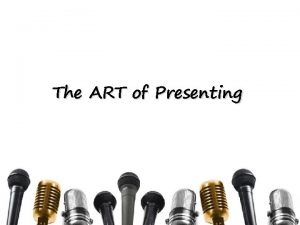Presenting Writing Without Words Alternative Literacies in Mesoamerica





















- Slides: 21

Presenting … Writing Without Words: Alternative Literacies in Mesoamerica and the Andes by Elizabeth Hill Boone (Editor), Walter D. Mignolo (Editor) Paperback: 322 pages Publisher: Duke University Press (March 1994) Product Dimensions: 9. 3 x 6. 6 x 0. 9 inches

Where were the Incas, Miztecs, Mayas and Olmecs?

This book deals with… 1. The concept of ‘writing without words’ 2. Literacy among the Pre-Columbian Maya 3. Aztec Pictorial histories 4. Reading of Codex Cospi (Reverse reading) 5. Mixtec writing : Embodied signs, Verbal art 6. Codices, Maps, Lienzos : As social contracts 7. Cartographic histories, Nahua identity 8. Colonial image of the Inca 9. Signs : “Book” in the new world 10. Object and Alphabet : Colonial period 11. Writing and Recorded knowledge in Colonial and Post-colonial situations

The editors’ aim… “…to confront (the) common definition of “writing” and our notions of what constitute writing system, … We have to think more broadly about visual and tactile systems of recording ionformation, to reach a broader definition of writing. ” - Elizabeth Boone “… to theorize coevolutionary histories of writing and, second to move toward a pluritopical interpretation of the history of writing in colonial situations when alphabetic literacy coalesced with non-Western writing systems. ” - Walter Mignolo

I see signs and symbols everywhere!!!

“disappearance of writing”… ?

Orality and Literacy Vedas Homer Plato West-African storytelling tradition East-Indian storytelling tradition To paint, make designs, write Mixtec term for “Books” TACU To hear, to listen

Pictographic traditions So Chikkan : Chinese script on bamboo Egyptian hieroglyphic

Table showing periods, cultures and city states of Mesoamerica Period Timespan Important cultures, cities, structures and styles Pre. Classic(Formative) B. C. 2000 -100 Gulf Coast cultures, Olmec, Early Pre-Classic B. C. 2000 -1000 Olmec centers San Lorenzo Tenochtitlan, La Venta, Chalcatzingo, San José Mogote Middle Pre-Classic B. C. 1000 -300 Late Olmec and Early Maya, Izapa, Tres Zapotes, Nakbé, Lamanai, Xunantunich Naj Tunich Late Pre-Classic B. C. 300 -100(or B. C. 0) Maya, Teotihuacan and Zapotec formative periods, Teotihuacan, Kaminaljuyú, Edzná, Monte Albán I & II Classic B. C. 100(or B. C. 0)900 Classic Maya Centers, Teotihuacan, Zapotecs Early Classic A. D. 300 -600 Teotihuacan apogee, Monte Albán III, Tikal, Palenque, Copán, Quiriguá, Classic Veracruz Civilization Late Classic A. D. 600 -900 Xochicalco, Cacaxtla, Uxmal, Toniná, Cobá, Post-Classic A. D. 900 - Aztec, Tarascan, Mixtec, Totonac Early Post-Classic A. D. 900 -1200 Cholula, Tula, Mitla, El Tajín, Tulum Late Post-Classic A. D. 1200 - 1519 Aztec, Tenochtitlan, Templo Mayor, Tzintzuntzan, Quiché and Mam maya, Utatlán, Cempoala

Introduction ) y e l al ) s m an eri Su 3200 q a r I ( ns a Ary 2600 s. V u d (In s Me 2500 pt ce ree G s) & a ) n ed (Ira nese s (V ians m i n Syr Ela Ch Arya I a( i m ta po o )& q a r y Eg 2250 1700 1600 ec m l O 1000 & rly a e BC as y a M AD

Aztec records without words PARTICIPANT who? EVENT what? LOCATION where? TIME when? From Codex Boturini

from Codex Boturini PARTICIPANT who? EVENT what? LOCATION where? TIME when?

from Codex Boturini (Karl says…) PARTICIPANT who? EVENT what? LOCATION where? TIME when? courtesy : http: //www. thing. net/~grist/ld/boturini. htm

Other codices Codex Mexicanus Codex Selden : marriage scene Codex Xolotl • Cartographic History • Migration History • Year-count Annals Inca writing : ? • Political senario, etc.

ancient Peruvian sailing reed boats Quipu Each cluster of knots is a digit, and there are three types of knots: simple overhand knots; long knots made up of two or more turns; and figure-of-eight knots. A number is represented as a sequence of knot clusters in base 10. Powers of ten are shown by position along the string, and this position is aligned between successive strands. Digits in positions for 10 and higher powers are represented by clusters of simple knots (e. g. 40 is four simple knots in a row in the "tens" position). Digits in the "ones" position are represented by long knots (e. g. 4 is a knot with 4 turns). Because of the way the knots are tied, the digit 1 cannot be shown this way and is represented in this position by a figure-of-eight knot. Zero is represented by the absence of a knot in the appropriate position. Because the ones digit is shown in a distinctive way, it is clear where a number ends. One strand on a quipu can therefore contain several numbers. For example, if 4 s represents four simple knots, 3 L represents a long knot with three turns, E represents a figure-of-eight knot and X represents a space: The number 731 would be represented by 7 s, 3 s, E The number 804 would be represented by 8 s, X, 4 L The number 107 followed by the number 51 would be represented by 1 s, X, 7 L, 5 s, E

Map of Cuauhtinchan showing the conquest of its rulers

The Conquest of Peru Francisco Pizarro's route of exploration during the conquest of Peru (1531 -1533)

Colonial Interventions Commissioned by the Spanish Viceroy of Peru? Spanish Missionary

Amoxtli … vuh… Codice Tudela Codice Borbonico

Glimpses of Mignolo’s topics… • Writing without Pens • Social Roles of Writing • Wisdom Signified with Signs • The Connection : Human Writing and writing of God • Book is not necessarily a book • Book : The Carrier of Knowledge • The White Man’s Burden

Reference : • Boone, E. H. & Mignolo, W (Eds. ), Writing without words: Alternative literacies in Mesoamerica and the Andes Durham, NC: Duke University Press, 1994 • Martí, Beatriz. “Maya Codices”, Maya Discovery, www. mayadiscovery. com/ing/history/codices. htm November, 2006. • “Quipu”, Wikipedia, http: //en. wikipedia. org/wiki/Quipu End of Slide-show
 Presenting someone else's words or ideas as your own is
Presenting someone else's words or ideas as your own is Writing without words
Writing without words Without title poem by diane glancy
Without title poem by diane glancy Without title poem by diane glancy
Without title poem by diane glancy Poetic devices in keeping quiet
Poetic devices in keeping quiet Geography of mesoamerica
Geography of mesoamerica What is the climate in mesoamerica
What is the climate in mesoamerica Terrace farming mesoamerica
Terrace farming mesoamerica Mesoamerica inca
Mesoamerica inca Inca vs maya
Inca vs maya What part of mexico were the aztecs from
What part of mexico were the aztecs from Mesoamerica society
Mesoamerica society Pisos ecológicos
Pisos ecológicos Climate of mesoamerica
Climate of mesoamerica Pre columbian america lesson 1 answers
Pre columbian america lesson 1 answers Mesoamerica culturas
Mesoamerica culturas Pinturas precolombinas de honduras
Pinturas precolombinas de honduras Civilizations of mesoamerica
Civilizations of mesoamerica Mesoamerica powerpoint
Mesoamerica powerpoint Mesoamerica vocabulary
Mesoamerica vocabulary Teotihuacanos mayas y zapotecos
Teotihuacanos mayas y zapotecos The peoples of north america and mesoamerica
The peoples of north america and mesoamerica
